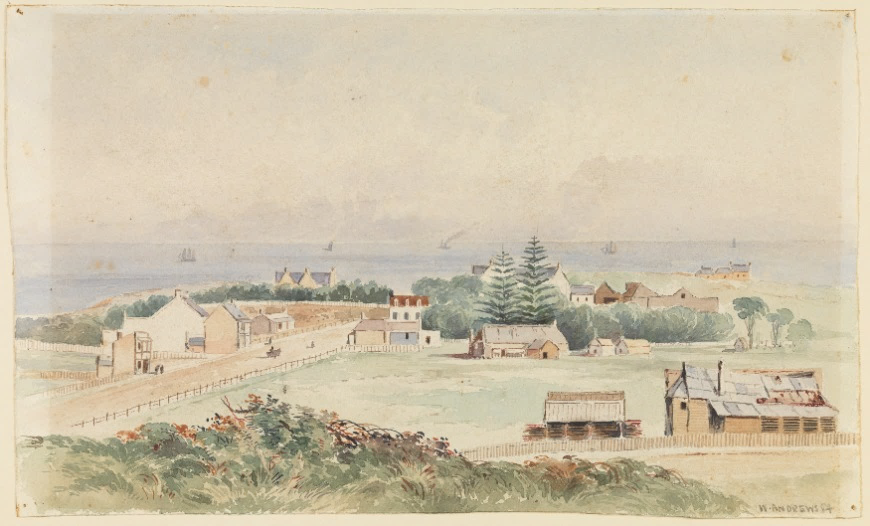A twice escaped convict who became an urban legend. The man who designed some of Parramatta’s most iconic buildings. An abandoned widow who became a successful businesswoman and the matriarch of a famous family. And the first white farmer of Australia who helped the colony survive. These are just a few of the stories I have uncovered and included in my project with Old Government House in Parramatta. My project is a coffee table book that aims to tell some of the well-known and less well-known stories of remarkable figures in the early colony of New South Wales. The work is based on a previous publication by the Friends of Old Government House, which I have adapted and edited to update existing stories and include a few new pieces. The result is a collection of ten stories that provide ten snapshots of what life was like in early Sydney and the sort of people who lived there.
Sydney and environs c. 1800, William Andrews, courtesy of the Dixon Library, State Library of New South Wales
I wanted to focus especially on women’s stories in my work. Spaces such as Old Government House are often closely tied to male figures such as the Governors and, in many ways, the early colony exists in the public imagination as quite a male-dominated space. Yet, women were an integral part of the early colony from its inception and their stories deserve to be told with the same ease and understanding as key male figures. With this in mind, I tried to center women within my project, especially within their own stories, and discuss them not in relation to who they were married to or the mother or daughter off but as who they were as individuals. In this, I was trying to argue that the role of women in history, and in the colony, is not to be remarkable through their relationships to men but in their own actions and intentions. The story of women in the colony deserves pride of place alongside the men and although their impact was different, it was no less significant.
Upon reflection, my work also argues for the individuality of historical figures. This was not something I set out to focus on but as I continued to research and uncover family stories and hidden details it dawned on me that I was writing about remarkable people, not just the remarkable things they did. I began to realize that in their own time the figures I wrote about were not, ‘John Watts ‘aide de camp’ and the first architect of Australia, but Watts, maybe even just John. A young man who had followed his father into the army before being given the chance to pursue something he loved. Because of this, all the figures in my project are referred to primarily by their first names, from perhaps the most well-known governor to a twice sentenced convict. I am not naïve enough to think that social standing and power did not enable influence, but I tried to discuss the figures in my work as the individuals they were before they became ‘remarkable’ in history.

The task of making a coffee table book out of these stories was quite daunting. I had never done something like this before, but I enjoyed the challenge of thinking not only about the information I included but what people would be interested in. Many times, I debated on whether to include a small detail here or there or to add a family rumor that couldn’t be rigorously fact-checked to make the story more engaging as well as informative. The inspiration to make a coffee table book came from my own family and my parents’ habit of flicking through them at breakfast. I decided I wanted to create something that people could read casually or bring up to friends revealing a section they found particularly interesting. One of my favorite things about Old Government House is the fact that I get to talk about history with people who also love history and I wanted to facilitate that a little bit in my project.
Hopefully, should all go well, the book will be available in the Old Government House gift shop. In doing so it will raise money for the House, something that is always needed in a charity organization. I hope it will be interesting to everyone. The work fundamentally tells the story of individuals and I hope that people will see a little bit of their own history in the pages, maybe something that reminds them of their own family here or their own journey to this settler colony. I do hope it will be especially interesting to female visitors or guides and remind them that there is a space for women’s history everywhere, even within ‘male dominated’ historical spaces.
I have had an amazing time working and volunteering at Old Government House, and I hope this book gives back some of the joy I have received from making it. Old Government House is open to visitors again and I encourage everyone who can to visit their website for more information and to book tickets!


